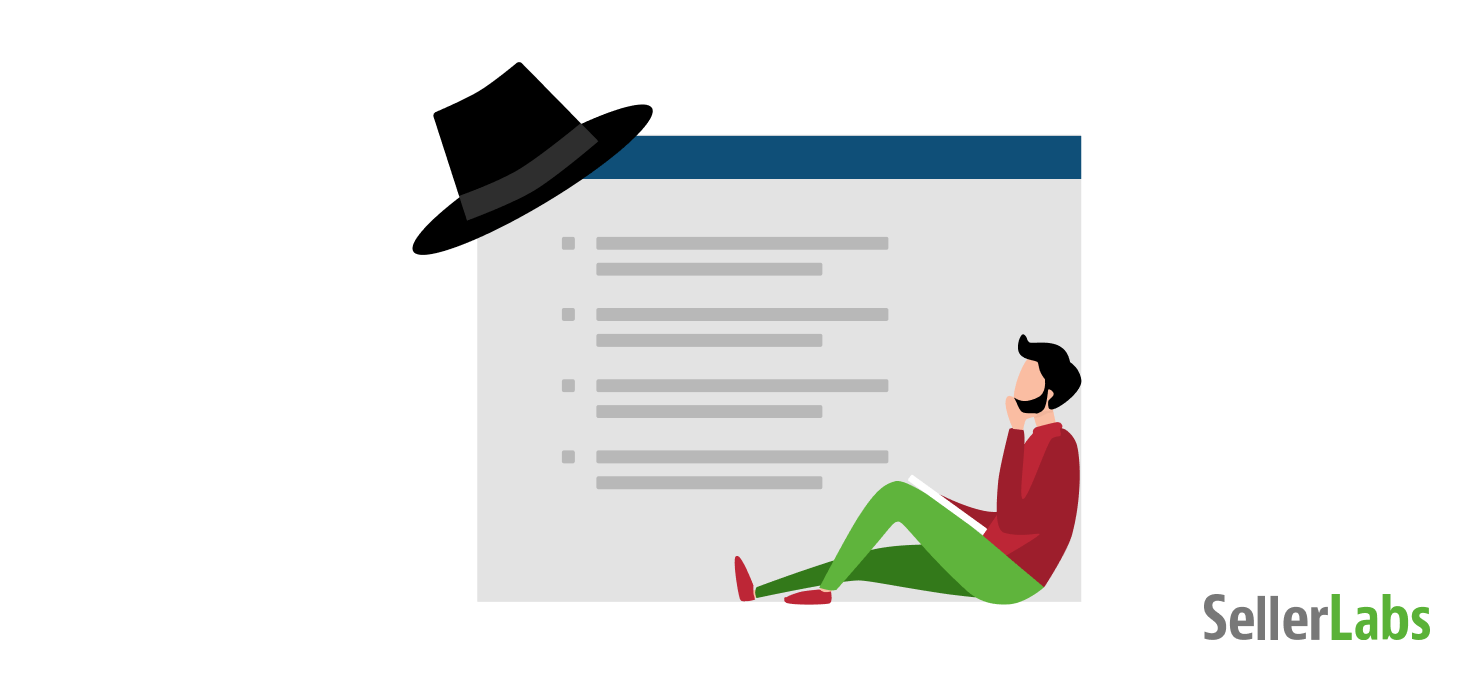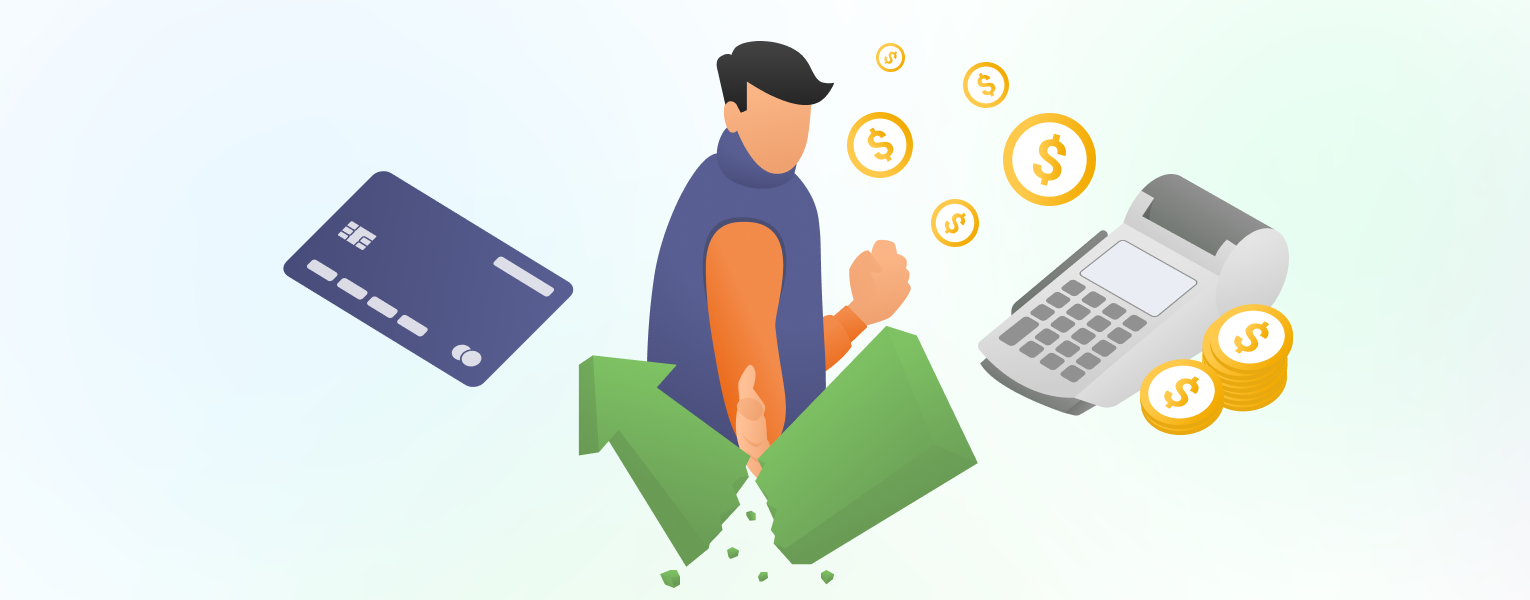[UPDATED] Understanding Amazon Black-Hat Tactics & Protecting Against Them: Your Terminology Guide

The Amazon ecosystem is rich with opportunity, but it’s also highly competitive, which inspires unethical schemes that seem to appear with dizzying speed. The amount and variety of unscrupulous behaviors on the Amazon Marketplace has become its own shadowy empire (known as the world of Amazon black-hat tactics), complete with its own language and jargon.
In order to understand the dangers you face and how to protect your eCommerce business, Amazon sellers and brand owners must understand the threats posed to them as well as the language of such dark dealings. To help you comprehend the perils of black-hat tactics used on Amazon and to assist you in protecting your business and prospering, Seller Labs presents this updated guide.
Understanding & Protecting Against Amazon Black-Hat Tactics: Your Terminology Guide (Updated July 2020)
Amazon Search Algorithm (A9)
A9 is the Amazon formula for selecting and displaying search results that best match a user’s input. The formula is not public and is constantly adjusted. Many factors affect where products appear in search results. A seller’s goal is to appear at the top of search results or to show up as close to the number-one position as possible. Black-hat scammers preying on the Amazon Marketplace promise to be able to manipulate the Amazon search algorithm and to “trick” it into listing particular products in the top spot by gaming relevance and performance elements.
Amazon Anti-Counterfeiting Policy
In its Amazon Anti-Counterfeiting policy, Amazon explicitly states that “Products offered for sale on Amazon must be authentic. The sale of counterfeit products is strictly prohibited. Failure to abide by this policy may result in loss of selling privileges, funds being withheld, and destruction of inventory in our possession.” Pretty clear, right? Yet counterfeiting is a wild beast running amok on Amazon and one that the retail giant has so far been unable to tame.
Amazon claims to have a zero-tolerance policy regarding counterfeit products, but many sellers and brand owners complain that as long as a product is generating revenue, Amazon has no interest in addressing the product’s authenticity or the seller’s integrity. Result? A marketplace of mistrust where black-hat scammers sell counterfeits that harm buyers as well as legitimate sellers. If you come across what you believe to be a counterfeit, report it to Amazon so that you can do your part in fighting fakes.
Amazon Brand Registry
Amazon claims that its Brand Registry “helps you protect your intellectual property and create an accurate and trusted experience for customers on Amazon.” It positions the Amazon Brand Registry as proactive protection where “Enrolled brands report an average of 99% fewer suspected infringements than before the launch of Brand Registry.” Amazon encourages trademark holders to register their brands by offering protection as well as special benefits, including exclusive PPC advertising such as Sponsored Brands Ads and Sponsored Display Ads, not available to unregistered brands. For more information, read our white paper, Getting Started with Amazon Brand Registry.
Amazon Project Zero
According to Amazon, Project Zero “leverages the combined strengths of Amazon and brands to drive counterfeits to zero.” We all know that eliminating counterfeits entirely is impossible, but we also know that Amazon needs to seriously tackle the issue and get that number of counterfeits on the marketplace as close to zero as possible. Project Zero, while somewhat of a pie-in-the-sky project, is well intentioned but its effectiveness remains a mystery like so many Amazon stats. We can surmise that the program is successful as Amazon has moved it from invitation only to widely available.
Joining Project Zero is available at no cost to brand-registered sellers. Some services are free but use of the product serialization service will incur a per-unit cost based on volume.
Project Zeros’s three prongs:
- Automated Protections: Amazon’s AI scans over 5 billion daily listing update attempts, looking for suspected counterfeits.
- Self-Service Counterfeit Removal: Brands no longer need to contact Amazon to remove counterfeit listings.
- Product Serialization: Brands apply a unique code on every unit they manufacture for an enrolled product, allowing Amazon to scan and confirm the authenticity of every one of those products purchased in Amazon’s stores. With this service, Amazon can detect and stop counterfeiting for every product unit before it reaches a customer.
Amazon Terms of Service (Program Policies, Seller Agreement, and Links Within)
These are, simply put, Amazon’s Program Policies and its Seller Agreement, both of which are lengthy documents that can seem impossible to navigate and adhere to. However, any Amazon-perceived violation of any of these stipulations can result in suspension and sellers are responsible for knowing these rules and following them while also keeping up with frequent policy changes.
Many sellers complain that these policies are inconsistently enforced and that legitimate sellers bear the brunt of nefarious activity done by unethical sellers. One area where even the most-honest sellers fail is in adhering to Amazon’s Communication Guidelines. These rules address buyer-seller messaging, buyer privacy rights, customer contact, and more, especially with regard to soliciting and obtaining seller feedback and product reviews. Given the importance of seller feedback and product reviews (and the limitations sellers face in getting both), black-hatters promising abundant positive ratings and reviews are plentiful. The best thing that a seller can do in order to stay compliant with Amazon’s guidelines and to not unwittingly participate in a black-hat scheme is to know the rules and follow them. We’ve spelled it out clearly in How to Get Reviews on Amazon and Improve Your Amazon Seller Feedback.
ASIN Piggybacking
Here’s a case where things get shady and a seller might not even know that black-hat tactics are at work. ASIN piggybacking entails:
- Finding a hot-selling product on Amazon
- Acquiring it at a discount or having replicas manufactured
- Selling it cheaper under the original listing
This can be done ethically (bringing the same product to market at a lower price because you can procure or produce it cheaper and without violating intellectual property—legitimate competition) or unethically (offering a cheap knockoff and passing it off as the same product as the original ASIN or bringing the actual product and violating intellectual property). If retail arbitrage is your Amazon business, be extra mindful of how and where you acquire goods and how you list them. It’s easy for a legitimate arbitrager to unknowingly buy counterfeit products in bulk and then pass them off as the real thing under another merchant’s ASIN.
Bad Actors
“Bad actors” is Amazon’s collective nonspecific term for malicious sellers or other scammers looking to take advantage of the marketplace. Now the phrase is used in multiple industries and beyond the business world, illustrating how the Amazon effect knows no bounds. The loose term “bad actors” allows Amazon to generalize without being clear about the offending behavior and without naming specific perpetrators. The nebulous meaning of “bad actors” also frees Amazon of responsibility for the malfeasance by implying that the problem is limited to just a few rogue scammers and not Amazon’s problem. Increasingly, buyers and sellers are pushing in and out of courts to make Amazon the responsible party when there is a product liability case or when bad actors sully the marketplace with black-hat tactics.
Black Hat (Amazon Black-Hat Tactics)
Think of old westerns where the villainous cowboy could be identified by hat he donned. You always knew the bad guy because he wore a black hat. Unfortunately, Amazon scammers aren’t so easily identifiable. Regardless, anyone encouraging or practicing techniques or anything else that violates Amazon’s Terms of Service (or the spirit of the ToS) is considered to be employing or encouraging Amazon black-hat tactics (even if he or she claims not to know the behavior is in violation).
Brushing
In this scam, a customer who makes an authentic purchase receives odd, low-cost products — or empty envelopes — usually from China. The recipient customer didn’t order these items, but a supplier has used customer information fraudulently to boost sales volumes or to create fake user accounts for posting fake reviews. The shipment to the real customer creates a fraudulent purchase indication on Amazon, which boosts the product’s ranking. Brushing is illegal in China so it’s now expanded to the American marketplace.
China Panic
A fear where American and European Amazon sellers have collectivized stereotypes, myths, and truths about Chinese manufacturing, enterprise, and even health. Sellers experiencing and/or perpetuating China panic are both fearful of the Chinese offering legitimate lower-cost versions of goods while also flooding the market with counterfeits and orchestrating Amazon black-hat practices. China panic has been exacerbated by the identification of Wuhan, China’s leading manufacturing hub, as the nucleus of the Coronavirus outbreak.
Counterfeit Products
Knockoff goods of various quality abound on Amazon and all marketplaces. They always have and they always will, but the ease of selling on Amazon and the openness of the marketplace have allowed for an abundance of these fakes. How deep does the problem go? Sellers may not even be aware that they are selling counterfeit goods if the counterfeiting is done well and unbeknownst to them at a design/manufacturing level. According to Craig Crosby, founder of TheCounterfeitReport.com, “China produces 80% of the world’s counterfeits.”
Get-Rich-Quick Schemes: Seminars, Classes, Workshops, Trainings, Webinars
Amazon black-hat tacticians often make their money not by directly manipulating products, listings, reviews, or the Amazon algorithm, but by presenting themselves as gurus and promising to teach others how to achieve huge performance gains. While there are some legitimate trainings for Amazon sellers, be wary of anyone promising Amazon success via paid sessions. The “instructor” may just take your registration fee and not even show up or deliver any information. If the instructor does show up and deliver information, the content shared may be comprised of techniques that will get you banned on Amazon. If something sounds too good to be true (and you’re asked to pay for it), it’s probably a scam.
Gray Hat (Gray-Hat Tactics)
Gray-hat tactics aren’t necessarily explicit violations of Amazon’s Terms of Service so much as shady methods of procuring an advantage or otherwise gaming the system. Often, gray-hat tacticians are coders who develop apps that exploit some element of Amazon data. If you’re unsure if something is gray-hat or not, ask yourself, “If I had to explain this to Amazon, would it get me suspended?” If the answer is yes, don’t do it.
Hacks
There’s a fine line between hacks and black-hat or gray-hat tactics. There’s nothing wrong with finding an advantage or creating an automation that saves you time in your Amazon-related tasks. But some hacks are really just cheats so beware anyone telling you that they have Amazon hacks to share.
Hijack (Hijacking a Listing)
Hijacking a listing can mean one of two things to the Amazon seller community:
- A party that does not own the listing — and should have no control over the listing’s details — makes changes to the listing, usually in the form of the description or images.
- A listing for a private-label product (where there should theoretically only be one seller, namely the PL brand itself) now has others selling the product within the listing, often undercutting the brand-owner in order to steal the Buy Box. Unless the non-brand-owner has negotiated resale terms with the brand, what is happening is a case of counterfeiting, intellectual property infringement, or a seller who will simply take payment without even shipping the product (or will ship some other product).
What these two hijacking definitions have in common is this: someone who doesn’t or shouldn’t own the listing or the product has interfered with the listing. Private-label sellers and brand owners can protect themselves from hijacking by checking their listings frequently to make sure there is no malicious activity and registering their product and brand on Amazon Brand Registry. Lear more at 3 Ways to Prevent an Amazon Listing Hijack.
Incentivized Reviews
Amazon banned incentivized reviews in October of 2016 yet the practice continues as sellers find workarounds and ways to justify these workarounds. How then should we define incentivized reviews so that it’s clear what’s okay and what’s not? Amazon’s Customer Product Reviews Policies makes it pretty clear what they consider to be incentivized reviews meriting suspension:
- A seller offers a third party a financial reward, discount, free products, or other compensation in exchange for a review on their product or their competitor’s product. This includes using services that sell customer reviews, websites, or social media groups.
- A seller offers to provide a refund or reimbursement after the buyer writes a review (including reimbursement via a non-Amazon payment method). This could be done via buyer-seller messaging on Amazon or directly contacting customers or using third-party services, websites, or social media groups.
- A seller uses a third-party service that offers free or discounted products tied to a review (for example, a review club that requires customers to register their Amazon public profile so that sellers can monitor their reviews).
- A seller inserts a request for a positive Amazon review or an incentive in exchange for a review into product packaging or shipping box.
A huge portion of Amazon black-hat tactics involve bad actors promising to deliver large quantities of positive reviews for the seller or negative reviews against competitors. In addition to these reviews being fake because there was no actual customer or purchase (a violation), they are also part of a for-profit scheme (another violation). Make it easy for yourself and sell with the understanding that anything that could be construed as a gift, payment, coupon, or other bonus offered in exchange for a review is not okay with Amazon.
Insider Intelligence/Internal Information
Increasingly, current and former Amazon employees have been caught sharing proprietary information and private customer data with black-hat tacticians or charging marketplace sellers for this insider intelligence.
Intellectual Property (IP) Infringement
Copyright, trademark, and patent laws apply on Amazon. Any attempt to reproduce products for which one does not hold rights is a violation that jeopardizes selling privileges on Amazon. If you believe that you have spotted a bad actor violating rules by employing Amazon black-hat tactics, check Amazon’s Intellectual property for Rights Owner policy and, if applicable, report intellectual property infringement to Amazon. If you have been falsely accused of IP infringement, or you need legal assistance regarding other IP issues, learn more about Fighting a Baseless Trademark Complaint on the Amazon Platform.
Just Launched Seller
JLS is a designation Amazon displays to indicate new sellers on the marketplace. And while there are indeed legitimate new sellers, Just Launched Seller has become a notorious euphemism for a bad actor who does one or both of the following: 1) a previously banned seller who has returned under a new guise in attempt to sell (and possibly scam) again, 2) a seller undercutting the Buy Box owner by a small amount so as to win the Buy Box and the sale but one who then either ships nothing to the buyer or shops a counterfeit product or another product entirely.
Misleading Discounts
If you’ve ever bought something on Amazon because it appears to be hugely discounted (the original price struck out and a new deeply discounted price shown), chances are that the seller has inflated the original price to make the product appear more valuable and to create a sense of urgency by running a sale. Likely, the product’s list price should be the equivalent of the so-called discounted price.
Orange Hat (Orange-Hat Tactics)
This entry may be the most confusing as it’s beyond the grayscale cowboy-hat spectrum. Start by answering this: What color do you associate with Amazon? Orange, right? Now you’re getting it. Orange-hat tactics are those put forth in those get-rich-quick seminars led by ex-Amazonians or current Amazon insiders. This information is proprietary and the presenters are violating their non-disclosure contracts with Amazon (not to mention making business hard for sellers playing by the rules).
Page Manipulation/ Listing Manipulation/ Variation Manipulation
Apparel variations such as size and color are legitimate parent-child ASIN connections as the garment is fundamentally the same item. Electronics variations such as the same iPhone charger in different colors are legitimately connected products that should be on one page. However putting an iPhone cable and USB hub on the same page in order to combine reviews for both is manipulation that skews sales numbers and confuses shoppers. Focus on the shopper not the review count.
Posers
In a day and age when it seems as if everyone sells on Amazon, it’s hard to believe that there are non-Amazon parties using the Amazon logo and claiming to be affiliated with Amazon. Unfortunately, it’s true. These black-hat scammers pose as Amazon employees or Amazon-endorsed partners in order to leverage the power and recognition of the Amazon name. Posers use the Amazon logo and send emails that appear to be from Amazon in order to get readers to provide private information (phishing) or to pay for courses or materials that appear to be for official Amazon services.
Review Farms
Pools of PBR (That’s “Paid By the Review,” not the iconic hipster beer Pabst Blue Ribbon) workers employed to click on products, leave reviews, upvote, or add to cart in order to create the impression of demand and sales velocity and product quality. Done in quantity, these review farms can skew a product’s true position.
Review Manipulation
Review manipulation is a broad category of violations to Amazon’s Terms of Service. These offenses include:
- Asking/paying friends, family, hired people to write
- Positive reviews for your product
- Negative reviews for a competitor’s product
- Implausible positive reviews for a competitor product that will suggest review fraud
- Asking buyers to leave you positive reviews rather than just reviews
- Using coercion or incentives to drive reviews
- Contacting buyers outside of the Amazon Buyer-Seller messaging channels to ask them to leave you reviews or to remove negative reviews they previously left
Using the Seller Labs Communication Center Powered by Feedback Genius is a great way to get reviews without running afoul of Amazon’s ToS. Get the Communication Center, along with other Amazon seller tools, when you try Seller Labs Pro free for 30 days.
Review Rings
Review rings are organized on Reddit, Facebook, and other social channels. Members of these groups are paid to write fake reviews in exchange for products or other payment. Sometimes review-ring organizers send reviewers the products and pay for actual reviews; other times, reviewers write with no actual product contact. The legitimate alternative for sellers? Ask customers for reviews and use automated software to help. Learn more and find out how to get reviews without falling afoul of Amazon’s guidelines, read Getting Amazon Seller Feedback Has Never Been More Difficult … Or More Important. Feedback Genius Can Help.
Sales Velocity
It would seem at first that increasing sales velocity would be a good thing that knows no bounds. After all, an Amazon seller’s goal is to try to sell more faster. But sales velocity that comes too fast and too furious often indicates that there is manipulation somewhere in the process. Amazon recognizes this, and in addition to looking for specific bad actors and black-hat tactics, it monitors sales velocity so that anything extreme can be flagged as suspicious activity to be investigated. Read more about Amazon Velocity Limits and Account Reviews.
Super URLs/ Custom URLs/ Golden URLs
These links involve creating custom URLs that include pre-loaded keywords for which the seller wishes to rank. When a shopper clicks one of these artificially stacked URLs, the Amazon algorithm associates the product with those keywords, thus mimicking an organic search result that would drive up the product’s ranking with regard to relevance. Understanding super URLs and what is/is not okay is tricky. Read Amazon Super URLs Exposed to get a better understanding.
Test Buys
When was the last time you checked the buyer experience for purchasing your product? You should be doing this periodically (legitimately by asking a friend to make a test buy) so that you can ensure that the fulfillment is as promised and the product is authentic. Many sellers claim to have performed test buys of their own products and received more counterfeits than authentic items. While troubling, this discovery is the catalyst for ferreting out nefarious activity and striking a blow against bad actors and Amazon black-hat tactics.
White Hat (White-Hat Tactics)
White-hat tactics are Amazon selling techniques, practices, and tools that are strictly on the up and compliant with Amazon’s ToS (on the page and in spirit). Suspension should be a concern for all Amazon sellers, even those employing only white-hat tactics. In addition to always complying with Amazon’s Terms of Service, you should always be prepared to protect yourself. Learn how at 3 Secrets to Avoiding Amazon Account Suspension and Amazon Suspension Prevention and Your Plan of Action.
Zombie Accounts
Amazon black-hat tacticians not only pay people to leave fake reviews but to also create fake accounts and to conduct searches and buys under these false accounts. This creates false keyword associations in the Amazon algorithm and drives sales so that the product appears higher in search results. One way to identify a zombie account is when you see a new account write 3-5 reviews in a short period of time and then stop.
Wrap Up: Bad Actors Will Continue to Come Up with New Amazon Black-Hat Tactics, but You Can Protect Yourself and Your Business.
In naming this document, we considered calling it “An A-to-Z Guide of Amazon Black-Hat Tactics.” However, we quickly realized that while the guide is technically that, such a term implies a completeness that we could not claim. While the document in its current iteration is comprehensive today, it cannot remain complete or up to date for long due to the nature of the subject matter. In truth, those who wish to circumvent rules or manipulate the system for their own benefit will never be fully eliminated. But that doesn’t mean that Amazon, ethical sellers, and white-hat providers should give up trying.
Competing with bad actors who use Amazon black-hat tactics is difficult. Some sellers may be tempted to participate in activity that is either in violation of Amazon’s Terms of Service or that goes against the spirit of fair play on the marketplace. To this we say, “We hear you and we understand, but stay the white-hat course (there are plenty of legitimate tools and practices that can help you prosper) and you will be rewarded for your integrity.” Success on Amazon is a long game and no promise of short-term reward is worth jeopardizing your business. In addition to avoiding suspension (or worse), you will outlast the cheaters and you will help to foster the Amazon Marketplace environment that buyers desire and can trust.
For all the tools you need in order to meet your business goals — while also staying Amazon compliant and avoiding black-hat dangers — try Seller Labs Pro. This bundle of white-hat apps will save you time and money while improving your processes for reporting, advertising, listing optimization, keyword discovery, and getting product reviews. Get a demo or start your FREE 30-day trial of Seller Labs Pro today.

Maria is an SEO Content Specialist at Seller Labs. Once captured by digital and content marketing in her student days, she keeps living and breathing it ever since.









